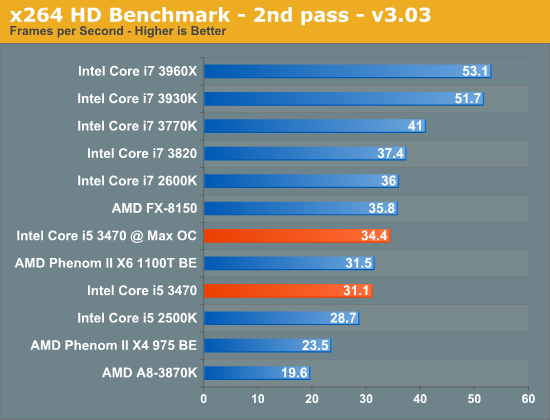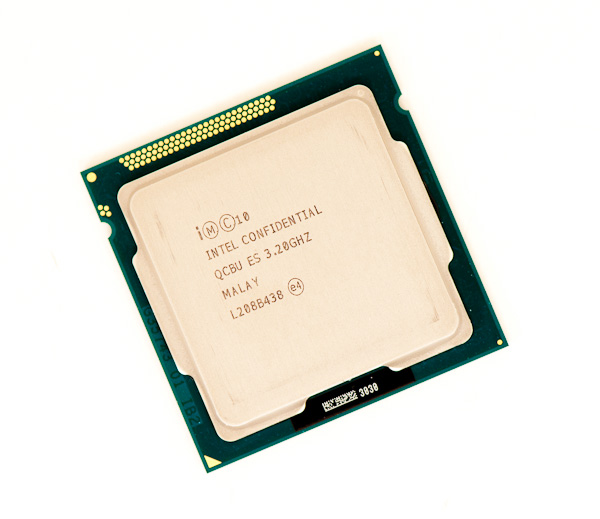Intel Core i5 3470 Review: HD 2500 Graphics Tested
by Anand Lal Shimpi on May 31, 2012 12:00 AM EST- Posted in
- CPUs
- Intel
- Ivy Bridge
- GPUs
Intel's first 22nm CPU, codenamed Ivy Bridge, is off to an odd start. Intel unveiled many of the quad-core desktop and mobile parts last month, but only sampled a single chip to reviewers. Dual-core mobile parts are announced today, as are their ultra-low-voltage counterparts for use in Ultrabooks. One dual-core desktop part gets announced today as well, but the bulk of the dual-core lineup won't surface until later this year. Furthermore, Intel only revealed the die size and transistor count of a single configuration: a quad-core with GT2 graphics.
Compare this to the Sandy Bridge launch a year prior where Intel sampled four different CPUs and gave us a detailed breakdown of die size and transistor counts for quad-core, dual-core and GT1/GT2 configurations. Why the change? Various sects within Intel management have different feelings on how much or how little information should be shared. It's also true that at the highest levels there's a bit of paranoia about the threat ARM poses to Intel in the long run. Combine the two and you can see how some folks at Intel might feel it's better to behave a bit more guarded. I don't agree, but this is the hand we've been dealt.
Intel also introduced a new part into the Ivy Bridge lineup while we weren't looking: the Core i5-3470. At the Ivy Bridge launch we were told about a Core i5-3450, a quad-core CPU clocked at 3.1GHz with Intel's HD 2500 graphics. The 3470 is near identical, but runs 100MHz faster. We're often hard on AMD for introducing SKUs separated by only 100MHz and a handful of dollars, so it's worth pointing out that Intel is doing the exact same here. It's possible that 22nm yields are doing better than expected and the 3470 will simply quickly take the place of the 3450. The two are technically priced the same so I can see this happening.
| Intel 2012 CPU Lineup (Standard Power) | |||||||||
| Processor | Core Clock | Cores / Threads | L3 Cache | Max Turbo | Intel HD Graphics | TDP | Price | ||
| Intel Core i7-3960X | 3.3GHz | 6 / 12 | 15MB | 3.9GHz | N/A | 130W | $999 | ||
| Intel Core i7-3930K | 3.2GHz | 6 / 12 | 12MB | 3.8GHz | N/A | 130W | $583 | ||
| Intel Core i7-3820 | 3.6GHz | 4 / 8 | 10MB | 3.9GHz | N/A | 130W | $294 | ||
| Intel Core i7-3770K | 3.5GHz | 4 / 8 | 8MB | 3.9GHz | 4000 | 77W | $332 | ||
| Intel Core i7-3770 | 3.4GHz | 4 / 8 | 8MB | 3.9GHz | 4000 | 77W | $294 | ||
| Intel Core i5-3570K | 3.4GHz | 4 / 4 | 6MB | 3.8GHz | 4000 | 77W | $225 | ||
| Intel Core i5-3550 | 3.3GHz | 4 / 4 | 6MB | 3.7GHz | 2500 | 77W | $205 | ||
| Intel Core i5-3470 | 3.2GHz | 4 / 4 | 6MB | 3.6GHz | 2500 | 77W | $184 | ||
| Intel Core i5-3450 | 3.1GHz | 4 / 4 | 6MB | 3.5GHz | 2500 | 77W | $184 | ||
| Intel Core i7-2700K | 3.5GHz | 4 / 8 | 8MB | 3.9GHz | 3000 | 95W | $332 | ||
| Intel Core i5-2550K | 3.4GHz | 4 / 4 | 6MB | 3.8GHz | 3000 | 95W | $225 | ||
| Intel Core i5-2500 | 3.3GHz | 4 / 4 | 6MB | 3.7GHz | 2000 | 95W | $205 | ||
| Intel Core i5-2400 | 3.1GHz | 4 / 4 | 6MB | 3.4GHz | 2000 | 95W | $195 | ||
| Intel Core i5-2320 | 3.0GHz | 4 / 4 | 6MB | 3.3GHz | 2000 | 95W | $177 | ||
The 3470 does support Intel's vPro, SIPP, VT-x, VT-d, AES-NI and Intel TXT so you're getting a fairly full-featured SKU with this part. It isn't fully unlocked, meaning the max overclock is only 4-bins above the max turbo frequencies. The table below summarizes what you can get out of a 3470:
| Intel Core i5-3470 | ||||||
| Number of Cores Active | 1C | 2C | 3C | 4C | ||
| Default Max Turbo | 3.6GHz | 3.6GHz | 3.5GHz | 3.4GHz | ||
| Max Overclock | 4.0GHz | 4.0GHz | 3.9GHz | 3.8GHz | ||
In practice I had no issues running at the max overclock, even without touching the voltage settings on my testbed's Intel DZ77GA-70K board:

It's really an effortless overclock, but you have to be ok with the knowledge that your chip could likely go even faster were it not for the artificial multiplier limitation. Performance and power consumption at the overclocked frequency are both reasonable:
| Power Consumption Comparison | ||||
| Intel DZ77GA-70K | Idle | Load (x264 2nd pass) | ||
| Intel Core i7-3770K | 60.9W | 121.2W | ||
| Intel Core i5-3470 | 54.4W | 96.6W | ||
| Intel Core i5-3470 @ Max OC | 54.4W | 110.1W | ||
Power consumption doesn't go up by all that much because we aren't scaling the voltage up significantly to get to these higher frequencies. Performance isn't as good as a stock 3770K in this well threaded test simply because the 3470 lacks Hyper Threading support:

Overall we see a 10% increase in performance for a 13% increase in power consumption. Power efficient frequency scaling is difficult to attain at higher frequencies. Although I didn't increase the default voltage settings for the 3470, at 3.8GHz (the max 4C overclock) the 3470 is selecting much higher voltages than it would have at its stock 3.4GHz turbo frequency:












67 Comments
View All Comments
Ryan Smith - Thursday, May 31, 2012 - link
Your completely right. We were in a rush and copied that passage from our original IVB review, which is no longer applicable.SteelCity1981 - Thursday, May 31, 2012 - link
Intel could have at least called it a 3500 and slap 2 more EU's onto it.fic2 - Thursday, May 31, 2012 - link
Agreed. I don't understand why Intel basically stood pat on the low end HD.But then again like everyone else I never understood why the HD3000 was only in the K series and maybe 5% of K series users don't have discreet gpu so the HD3000 isn't being used.
CeriseCogburn - Monday, June 11, 2012 - link
Good point. Lucid logic tried to fix that some, and did a decent job, and don't forget quick sync, plus now with zero core amd cards, and even low idle power 670's and 680's, leaving on SB K chip hd3000 cores looks even better - who isn't trained in low power if they have a video card, after all it's almost all people rail about for the last 4 years.So if any of that constant clamor for a few watts power savings has any teeth whatsoever, every person with an amd card before this last gen will be using the SB HD3000 and then switching on the fly to gaming with lucid logic.
n9ntje - Thursday, May 31, 2012 - link
So this must be a midrange desktop chip? Horrendous performance on the graphics side from Intel again.Very curious how AMD's trinity dekstop will perform, at the same pricerange it will be obvious it will obliterate Intel's offerings on the graphics side. What's more impressive AMD is still on 32nm..
7Enigma - Thursday, May 31, 2012 - link
For me this IS the perfect chip. No use for the GPU so cheaper = better. I would need a K model though for OC'ing potential, but I'm glad to see that if I can't have my CPU-only (no GPU) chip, at least I can have a hacked down version that is more in line with a traditional CPU.silverblue - Thursday, May 31, 2012 - link
What Intel should really be doing here is offering the 4000 on all i3s and some i5s to offset the reduced CPU performance. If you want to give AMD something to think about, HD 4000 on an Ivy Bridge dual core is very much the right way of going about it.CeriseCogburn - Friday, June 1, 2012 - link
Then Intel has a lame trinity level cpu next to a losing gpu.I think Intel will stick with it's own implementations, don't expect to be hired as future product manager.
ShieTar - Thursday, May 31, 2012 - link
Interestingly enough, Intel will also happily sell you what is basically the same chip, without any GPU, 100 MHz slower but with 2MB extra L3-Cache for the same price. They call that offer Xeon E3-1220V2. And it is 69W TDP, not 77W as the i5-3470.Who knows, the bigger Cache might even make it the better CPU for a not-overclocking gamer. If normal boards support it.
Pazz - Thursday, May 31, 2012 - link
Anand,Following on from your closing statement with regards to the HD 4000 being the miniumum, will you be doing a review of the 3570K? Surely with this model being the lowest budget Ivy HD4000 chip, it'll be a fairly popular option for many system builders and OEM's.